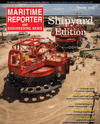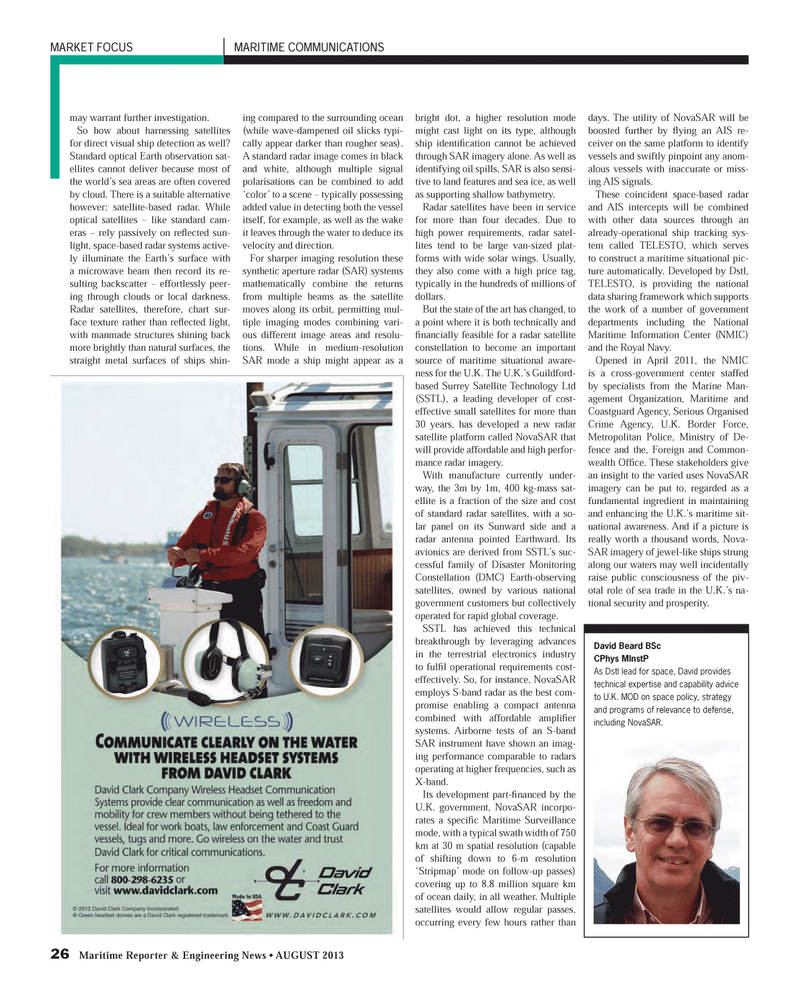
Page 26: of Maritime Reporter Magazine (August 2013)
Shipyard Edition
Read this page in Pdf, Flash or Html5 edition of August 2013 Maritime Reporter Magazine
26 Maritime Reporter & Engineering News ? AUGUST 2013 MARKET FOCUS MARITIME COMMUNICATIONS may warrant further investigation.So how about harnessing satellites for direct visual ship detection as well? Standard optical Earth observation sat-ellites cannot deliver because most of the world?s sea areas are often covered by cloud. There is a suitable alternative however: satellite-based radar. While optical satellites ? like standard cam-eras ? rely passively on reß ected sun- light, space-based radar systems active-ly illuminate the Earth?s surface with a microwave beam then record its re-sulting backscatter ? effortlessly peer- ing through clouds or local darkness. Radar satellites, therefore, chart sur- face texture rather than reß ected light, with manmade structures shining back more brightly than natural surfaces, the straight metal surfaces of ships shin-ing compared to the surrounding ocean (while wave-dampened oil slicks typi-cally appear darker than rougher seas). A standard radar image comes in black and white, although multiple signal polarisations can be combined to add ?color? to a scene ? typically possessing added value in detecting both the vessel itself, for example, as well as the wake it leaves through the water to deduce its velocity and direction. For sharper imaging resolution these synthetic aperture radar (SAR) systems mathematically combine the returns from multiple beams as the satellite moves along its orbit, permitting mul-tiple imaging modes combining vari-ous different image areas and resolu- tions. While in medium-resolution SAR mode a ship might appear as a bright dot, a higher resolution mode might cast light on its type, although ship identiÞ cation cannot be achieved through SAR imagery alone. As well as identifying oil spills, SAR is also sensi-tive to land features and sea ice, as well as supporting shallow bathymetry. Radar satellites have been in service for more than four decades. Due to high power requirements, radar satel-lites tend to be large van-sized plat- forms with wide solar wings. Usually, they also come with a high price tag, typically in the hundreds of millions of dollars. But the state of the art has changed, to a point where it is both technically and Þ nancially feasible for a radar satellite constellation to become an important source of maritime situational aware-ness for the U.K. The U.K.?s Guildford- based Surrey Satellite Technology Ltd (SSTL), a leading developer of cost-effective small satellites for more than 30 years, has developed a new radar satellite platform called NovaSAR that will provide affordable and high perfor- mance radar imagery. With manufacture currently under- way, the 3m by 1m, 400 kg-mass sat- ellite is a fraction of the size and cost of standard radar satellites, with a so-lar panel on its Sunward side and a radar antenna pointed Earthward. Its avionics are derived from SSTL?s suc- cessful family of Disaster Monitoring Constellation (DMC) Earth-observing satellites, owned by various national government customers but collectively operated for rapid global coverage.SSTL has achieved this technical breakthrough by leveraging advances in the terrestrial electronics industry to fulÞ l operational requirements cost- effectively. So, for instance, NovaSAR employs S-band radar as the best com-promise enabling a compact antenna combined with affordable ampli Þ er systems. Airborne tests of an S-band SAR instrument have shown an imag-ing performance comparable to radars operating at higher frequencies, such as X-band.Its development part-Þ nanced by the U.K. government, NovaSAR incorpo-rates a speciÞ c Maritime Surveillance mode, with a typical swath width of 750 km at 30 m spatial resolution (capable of shifting down to 6-m resolution ?Stripmap? mode on follow-up passes) covering up to 8.8 million square km of ocean daily, in all weather. Multiple satellites would allow regular passes, occurring every few hours rather than days. The utility of NovaSAR will be boosted further by ß ying an AIS re- ceiver on the same platform to identify vessels and swiftly pinpoint any anom-alous vessels with inaccurate or miss-ing AIS signals. These coincident space-based radar and AIS intercepts will be combined with other data sources through an already-operational ship tracking sys-tem called TELESTO, which serves to construct a maritime situational pic-ture automatically. Developed by Dstl, TELESTO, is providing the national data sharing framework which supports the work of a number of government departments including the National Maritime Information Center (NMIC) and the Royal Navy. Opened in April 2011, the NMIC is a cross-government center staffed by specialists from the Marine Man-agement Organization, Maritime and Coastguard Agency, Serious Organised Crime Agency, U.K. Border Force, Metropolitan Police, Ministry of De-fence and the, Foreign and Common-wealth OfÞ ce. These stakeholders give an insight to the varied uses NovaSAR imagery can be put to, regarded as a fundamental ingredient in maintaining and enhancing the U.K.?s maritime sit- uational awareness. And if a picture is really worth a thousand words, Nova-SAR imagery of jewel-like ships strung along our waters may well incidentally raise public consciousness of the piv-otal role of sea trade in the U.K.?s na- tional security and prosperity. David Beard BSc CPhys MInstPAs Dstl lead for space, David provides technical expertise and capability advice to U.K. MOD on space policy, strategy and programs of relevance to defense, including NovaSAR.MR #8 (26-33).indd 26MR #8 (26-33).indd 268/2/2013 9:00:40 AM8/2/2013 9:00:40 AM

 25
25

 27
27
